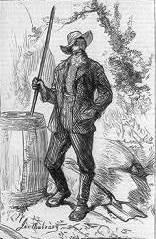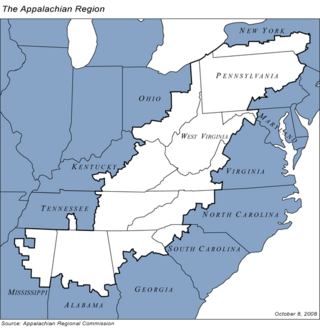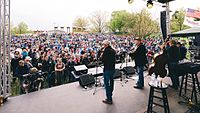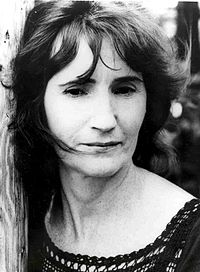
Hillbilly is a term for people who dwell in rural, mountainous areas in the United States, primarily in the Appalachian region. As people migrated out of the region during the Great Depression, the term spread northward and westward with them.

Appalachia is a socio-economic region located in the central and southern sections of the Appalachian Mountains of the Eastern United States. It stretches from the western Catskill Mountains in the east end of the Southern Tier of New York state west and south into Pennsylvania, continuing on through the Blue Ridge Mountains into northern Georgia, and through the Great Smoky Mountains from North Carolina into Tennessee and northern Alabama. In 2020, the region was home to an estimated 26.1 million people, of whom roughly 80% were white.

Hazel Jane Dickens was an American bluegrass singer, songwriter, double bassist and guitarist. Her music was characterized not only by her high, lonesome singing style, but also by her provocative pro-union, feminist songs. Cultural blogger John Pietaro noted that "Dickens didn’t just sing the anthems of labor, she lived them and her place on many a picket line, staring down gunfire and goon squads, embedded her into the cause." The New York Times extolled her as "a clarion-voiced advocate for coal miners and working people and a pioneer among women in bluegrass music." With Alice Gerrard, Dickens was one of the first women to record a bluegrass album.

Mountain whites were white Americans living in Appalachia and the inland region of the Antebellum South. They were generally small farmers, who inhabited the valleys of the Appalachian range from western Virginia spanning down to northern Georgia and northern Alabama.

Hampden is a neighborhood located in northern Baltimore, Maryland, United States. Roughly triangular in shape, it is bounded to the east by the neighborhood Wyman Park, to the north by Roland Park at 40th and 41st Street, to the west by the Jones Falls Expressway, and to the south by the neighborhood Remington. The Homewood campus of the Johns Hopkins University is a short distance to the east.

Charles Village is a neighborhood located in the north-central area of Baltimore, Maryland, USA. It is a diverse, eclectic, international, largely middle-class area with many single-family homes that is in proximity to many of Baltimore's cultural amenities. Nearby are the Baltimore Museum of Art, The Homewood campus of The Johns Hopkins University, Olmstead's Wyman Park, and the weekly Waverly Farmers Market, and the arts district, Station North. Homes are exemplary Baltimore brick and stone row houses, many dating from the 1890s. Running from downtown north is the historic boulevard, Charles Street, where Baltimore's Easter Promenade once took place.

Appalachian music is the music of the region of Appalachia in the Eastern United States. Traditional Appalachian music is derived from various influences, including the ballads, hymns and fiddle music of the British Isles, the African music and blues of early African Americans, and to a lesser extent the music of Continental Europe.

"Pigtown", also known as "Washington Village" is a neighborhood in the southwest area of Baltimore, bordered by Martin Luther King Jr. Boulevard to the east, Monroe Street to the west, Russell Street to the south, and West Pratt Street to the north. The neighborhood acquired its name during the second half of the 19th century, when the area was the site of butcher shops and meat packing plants to process pigs transported from the Midwest on the B&O Railroad; they were herded across Ostend and Cross Streets to be slaughtered and processed.

The culture of the Southern United States, Southern culture, or Southern heritage, is a subculture of the United States. From its many cultural influences, the South developed its own unique customs, dialects, arts, literature, cuisine, dance, and music. The combination of its unique history and the fact that many Southerners maintain—and even nurture—an identity separate from the rest of the country has led to it being one of the most studied and written-about regions of the United States.

Highlandtown is a neighborhood of Baltimore, Maryland, United States.

In the United States, the Hillbilly Highway is the out-migration of Appalachians from the Appalachian Highlands region to industrial cities in northern, midwestern, and western states, primarily in the years following World War II in search of better-paying industrial jobs and higher standards of living. Many of these migrants were formerly employed in the coal mining industry, which started to decline in 1940s. The word hillbilly refers to a negative stereotype of people from Appalachia. The term hillbilly is considered to be a modern term because it showed up in the early 1900s. Though the word is Scottish in origin, but doesn't derive from dialect. In Scotland, the term "hill-folk" referred to people who preferred isolation from the greater society and the term "billy" referred to someone being a "companion" or "comrade". The Hillbilly Highway was a parallel to the better-known Great Migration of African-Americans from the south.
Urban Appalachians are people from Appalachia who are living in metropolitan areas outside of the region. Because migration has been occurring for decades, most are not first generation migrants from the region but are long-term city dwellers. People have been migrating from Appalachia to cities outside the region ever since many of these cities were founded. It was not until the period following World War II, however, that large-scale migration to urban areas became common due to the decline of coal mining and the increase in industrial jobs available in the Midwest and Northeast. The migration of Appalachians is often known as the Hillbilly Highway.

Appalachia is a socio-economic region of the Eastern United States. Home to over 25 million people, the region includes mountainous areas of 13 states: Mississippi, Alabama, Pennsylvania, New York, Georgia, South Carolina, North Carolina, Tennessee, Virginia, Kentucky, Ohio, Maryland, as well as the entirety of West Virginia.

Appalachian Americans, or simply Appalachians, are Americans living in the geocultural area of Appalachia in the eastern United States, or their descendants.

Remington is a neighborhood in northern Baltimore bordered to the north by Hampden, Wyman Park, and Johns Hopkins University and to the east by Charles Village. The southernmost boundary is North Avenue and the long southwestern boundary is formed by Falls Road in the I-83 corridor. The neighborhood is split between two Baltimore City Council Districts.

There have been a variety of ethnic groups in Baltimore, Maryland and its surrounding area for 12,000 years. Prior to European colonization, various Native American nations have lived in the Baltimore area for nearly 3 millennia, with the earliest known Native inhabitants dating to the 10th millennium BCE. Following Baltimore's foundation as a subdivision of the Province of Maryland by British colonial authorities in 1661, the city became home to numerous European settlers and immigrants and their African slaves. Since the first English settlers arrived, substantial immigration from all over Europe, the presence of a deeply rooted community of free black people that was the largest in the pre-Civil War United States, out-migration of African-Americans from the Deep South, out-migration of White Southerners from Appalachia, out-migration of Native Americans from the Southeast such as the Lumbee and the Cherokee, and new waves of more recent immigrants from Latin America, the Caribbean, Asia and Africa have added layers of complexity to the workforce and culture of Baltimore, as well as the religious and ethnic fabric of the city. Baltimore's culture has been described as "the blending of Southern culture and [African-American] migration, Northern industry, and the influx of European immigrants—first mixing at the port and its neighborhoods...Baltimore’s character, it’s uniqueness, the dialect, all of it, is a kind of amalgamation of these very different things coming together—with a little Appalachia thrown in...It’s all threaded through these neighborhoods", according to the American studies academic Mary Rizzo.

The Appalachian region and its people have historically been stereotyped by observers, with the basic perceptions of Appalachians painting them as backwards, rural, and anti-progressive. These widespread, limiting views of Appalachia and its people began to develop in the post-Civil War; Those who "discovered" Appalachia found it to be a very strange environment, and depicted its "otherness" in their writing. These depictions have persisted and are still present in common understandings of Appalachia today, with a particular increase of stereotypical imagery during the late 1950s and early 1960s in sitcoms. Common Appalachian stereotypes include those concerning economics, appearance, and the caricature of the "hillbilly."

The history of White Americans in Baltimore dates back to the 17th century when the first white European colonists came to what is now Maryland and established the Province of Maryland on what was then Native American land. White Americans in Baltimore are Baltimoreans "having origins in any of the original peoples of Europe, the Middle East or North Africa." Majority white for most of its history, Baltimore no longer had a white majority by the 1970s. As of the 2010 census, white Americans are a minority population of Baltimore at 29.6% of the population. White Americans have played a substantial impact on the culture, dialect, ethnic heritage, history, politics, and music of the city. Since the earliest English settlers arrived on the shores of the Chesapeake Bay, Baltimore's white population has been sustained by substantial immigration from all over Europe, particularly Central Europe, Eastern Europe, and Southern Europe, as well as a large out-migration of White Southerners from Appalachia. Numerous white immigrants from Europe and the European diaspora have immigrated to Baltimore from the United Kingdom, Germany, Ireland, Poland, Italy, the Czech Republic, Slovakia, Lithuania, Russia, Ukraine, Spain, France, Canada, and other countries, particularly during the late 19th century and early 20th century. Smaller numbers of white people have immigrated from Latin America, the Caribbean, the Middle East, North Africa, and other non-European regions. Baltimore also has a prominent population of white Jews of European descent, mostly with roots in Central and Eastern Europe. There is a smaller population of white Middle Easterners and white North Africans, most of whom are Arab, Persian, Israeli, or Turkish. The distribution of White Americans in Central and Southeast Baltimore is sometimes called "The White L", while the distribution of African Americans in East and West Baltimore is called "The Black Butterfly."
The city of Chicago, Illinois is home to a significant Appalachian population. The Appalachian community has historically been centered in the neighborhood of Uptown. Beginning after World War I, Appalachian people moved to Chicago in droves seeking jobs. Between 1940 and 1970, approximately 3.2 million Appalachian and Southern migrants settled in Chicago and elsewhere in the Midwest. Due to immigration restrictions in the 1920s, personnel managers in Chicago encouraged working-class migrants from the Upland South to fill those jobs. The culture of Chicago has been significantly influenced by the culture, music, and politics of Appalachia. The majority of people of Appalachian heritage in Chicago are white or black, though Appalachian people can be of any race, ethnicity, or religion.
The Metro Detroit region of Michigan is home to a significant Appalachian population, one of the largest populations of Urban Appalachians in the United States. The most common state of origin for Appalachian people in Detroit is Kentucky, while many others came from Tennessee, West Virginia, Virginia, Ohio, and elsewhere in the Appalachia region. The Appalachian population has historically been centered in the Detroit neighborhoods of Brightmoor, Springwells, Corktown and North Corktown, as well as the Detroit suburbs of Hazel Park, Ypsilanti, Taylor, and Warren. Beginning after World War I, Appalachian people moved to Detroit in large numbers seeking jobs. Between 1940 and 1970, approximately 3.2 million Appalachian and Southern migrants settled in the Midwest, particularly in large cities such as Detroit and Chicago. This massive influx of rural Appalachian people into Northern and Midwestern cities has been called the "Hillbilly Highway". The culture of Metro Detroit has been significantly influenced by the culture, music, and politics of Appalachia. The majority of people of Appalachian heritage in Metro Detroit are Christian and either white or black, though Appalachian people can be of any race, ethnicity, or religion.



















